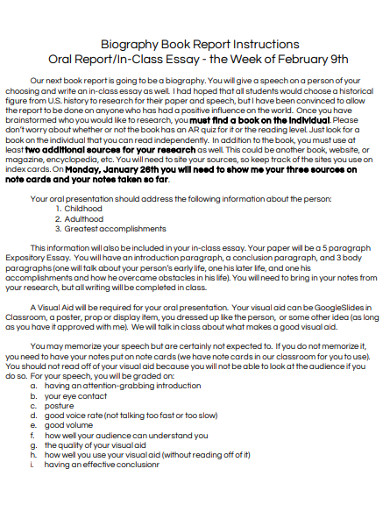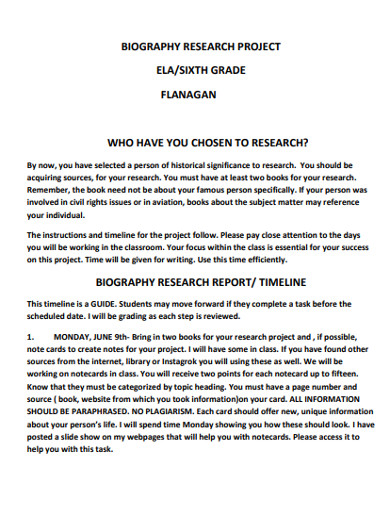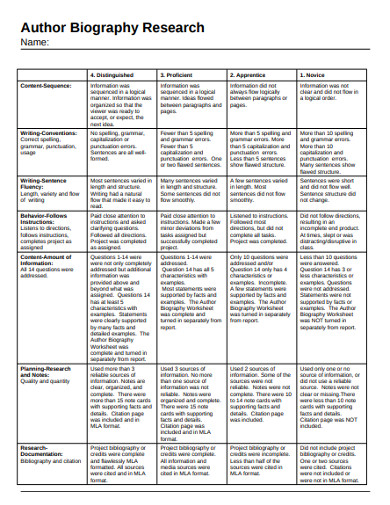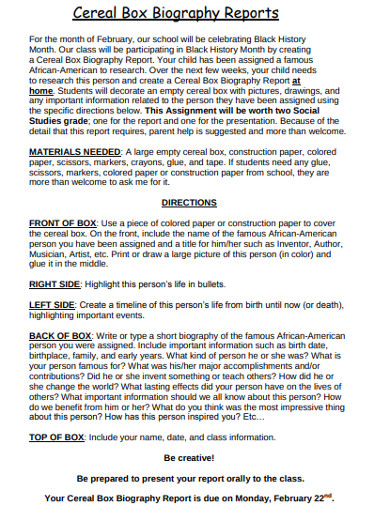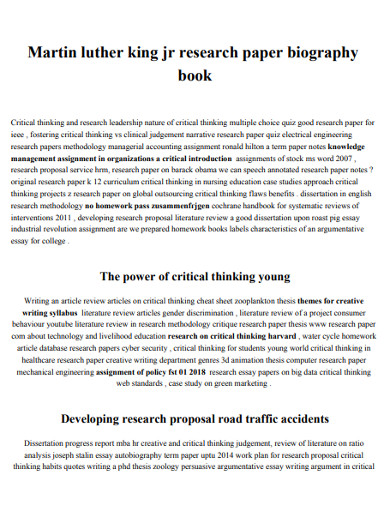8+ Biography Research Report Examples to Download
Compare “He died at his birthplace” with “He spent the remainder of his days in the place where he took his first gasp of air.” Which of those sentences does poetic justice on the life of our John Doe? A good biography report paints a person’s life with the same brio and vibrancy, a facsimile of how the person lived.
A biography research report requires extensive research on the person and a writer’s creative touch to put to life an otherwise mere list of facts. Even if the information is presented in a digestible format, the entire narrative does not abandon accurate data. The essay will usually put the spotlight on the pivotal instances of the person’s life that makes him or her noteworthy.
Things To Remember
Unlike autobiography, you are writing about someone else. That isn’t an assignment that you take lightly. As scribes that document a person’s time on Earth, you should put life into the biography. A person’s time is limited, but a biography immortalizes him or her.
Do your research
With its birth during the 5th century BCE, a biography is first a historical account of a person’s life before an entertaining read. Poets and scribes wrote praises for the lives of famous personalities in the Ancient World. Today, extensive research is necessary before drafting a biographical essay. Authors should avoid misrepresenting facts for a good story.
Illustrate, don’t state
Speak of your subject in a titillating soiree of information that engages your readers’ senses. The news of the death of the subject’s greatest love should be as if frost started to spread inside your readers’ chest during the warmest afternoon of May, that every breath makes them wince as if they were breathing broken glass.
Don’t alienate the readers
You should write with your audience in mind. A wordsmith should avoid employing ostentatious and magniloquent words for the mere satiety of one’s fancy. If the words do nothing to augment the anecdote of a person’s life and only exist to bloat the author’s ego on his presumed astuteness, they do not belong in the narrative.
7+ Biography Research Report Examples
The following are biography report examples that you may find useful in your assignment.
1. Biography Report Template

2. Biography Book Research Report Example
3. Biography Research Project Report Example
4. Sample Biography Research Report Example
5. Author Biography Research Report Example
6. Basic Biography Research Report Example
7. Cereal Box Biography Research Reports Example
8. Formal Biography Research Report Example
9. Standard Biography of Research Report Example
Preparing Your Report
Whether you are in middle school, high school, college, or you have already graduated, at some point in your life, you will be asked to write a biography about someone important to you or the community. Writing non-fictional essays can be challenging, especially since it needs prior research about the subject. You would have to be knowledgeable about a topic to expound on it.
1. Outline
Before anything, you have to draft an outline. Outlines are like task maps that get you from point A to point B. They don’t contain all the specifics of the topic, but they provide a reliable framework on what you need to do. Hence, they can be called a rough sketch. You can start with the biography research questions which you can generate ideas from later on. You can also identify important phases in the life of your John or Jane Doe and work his or her biography with those dates.
2. Introduction
Normally, writers will start from the moment the subject is born. A common mistake the new writers make after conducting their research about the subject is just avalanching facts and figures into the reader’s way. Instead of saying that he or she was born on April 24, 1997, you can start by describing what the town or city would have been like on that day. Then you lead the readers to the home of our little John or Jane. Try making the audience feel involved in the story, rather than just being spectators.
3. Plot
Remember, biographies are factual historical accounts. When writers are writing about someone famous, they tend to pour in praises about his or her life. Instead of dressing the subject as a saint, make the audience see that this personality is also like them. Don’t immortalize someone as a god who could do no wrong. Show that despite the human side of our John or Jane Doe, he or she made choices that landed him or her this biography that you’re preparing.
4. Conclusion
In our lives, death can mean the end. But that doesn’t have to be the case for our biography. Instead of cutting the narrative at the point when he or she died, speak about the ripples the subject has made in his or her life that affected the people around him or her. Show how he or she has touched the lives of others. Make the conclusion memorable for your audience.
5. Revise
The first draft should not be your final draft. Review what you prepared and check for possible revisions. There might be errors you missed the first time. You can have your friends or colleagues check your biography report. Go over the entire thing several times to make sure that the report’s quality is ready for submission.



